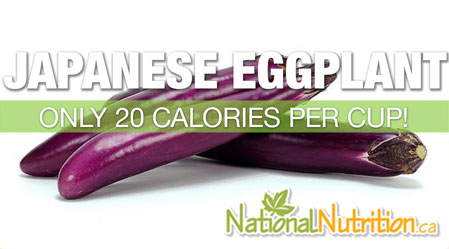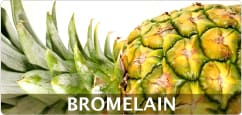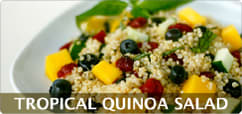
Only 20 calories per cup!
Japanese Eggplant: A Food Rich In Antioxidants
Updated Apr. 17th, 2024 | Read Time: 3 Minutes | What You Will Learn:
- Plant History
- What is Japanese Eggplant Used For?
- Health Benefits of Japanese Eggplant
- A Delicious Recipe To Try
- Shopping For Japanese Eggplant
Have you noticed skinny, long eggplants in the grocery store or farmer's markets? You may have thought they were eggplants that were picked too early if you are used to more pear-shaped eggplants, however what you are seeing is a Japanese eggplant.
Plant History
Japanese eggplant is a variety of eggplant that is in season from July to October and it's typically longer, thinner and more corkscrewed in shape compared to the pear-shaped American eggplant. This variety is less bitter, almost seedless and has a thinner skin, which makes it more versatile for cooking. The spongy, nearly seedless flesh allows it to soak in the flavour of sauces and marinades. If you're an imaginative cook, you'll love it!
What is Japanese Eggplant Used For?
Southern and Southeast Asian dishes often incorporate Japanese eggplant and you can use it in any dish that you would use American eggplant in. It's a low-calorie (20 calories per cup), high-fibre food that is full of nutrients like antioxidants, minerals and vitamins. It's particularly high in vitamin C, folate, potassium and manganese. Antioxidants found in the purple skin of this eggplant variety, like nasunin, protect the cell membranes in the brain, which is important as you age. Consider eggplant food for your brain.
Health Benefits of Japanese Eggplant
Like American eggplant, this variety is an important dietary staple because it is low in calories, high in fibre and nutrient-dense. It is a member of the nightshade family, like tomatoes, and is classified as a fruit. Its Antioxidants prevent free radical damage, particularly in the brain but also throughout the body.
A Delicious Recipe To Try
Try this tasty recipe, courtesy of Flavor Feed, to have as a side dish at your next meal or add to a stir fry.
- Slice the eggplant on the diagonal ¾ to 1 inch thick, larger pieces cut in half lengthwise. Transfer the eggplant slices to a medium bowl, sprinkle with the cornstarch, and toss to coat evenly. Heat the oil in a 12-inch skillet or wok over medium-high heat. Add just enough eggplant to create a single layer so that no slices overlap. Cook, flipping once, until the eggplant is golden and a bit charred in places, 2-½ to 3 minutes total. Transfer the eggplant to a paper-towel-lined rimmed baking sheet. Repeat with the remaining eggplant, adding more oil to the pan as needed.
- Wipe the pan clean, then add the sesame oil over low heat. Add the garlic and ginger, and cook, stirring, until fragrant, about 20 seconds. Return the eggplant to the pan. Add the soy sauce, and toss to combine, about 1 minute. Serve topped with the scallion, and season to taste with more soy sauce.
Ingredients
- 1 ½ to 2 pounds Japanese or Chinese eggplant
- 4 - 6 Tablespoons cornstarch
- 3 Tablespoons peanut or vegetable oil plus more as needed
- 2 Tablespoons Asian toasted sesame oil
- 5 cloves garlic minced
- 1 Tablespoon minced fresh ginger
- 2 Tablespoons low-sodium soy sauce plus more as needed
- Sliced scallions or microgreens for garnish
Shopping For Japanese Eggplant
When buying Japanese eggplant, look for a firm, heavy one. This variety has a shorter shelf life than regular eggplant, so if you choose a firm one, it should last up to a week in the fridge. The great thing about this vegetable is that the skin is thinner and not as tough as regular eggplant. Keep the skin on because that's where the powerful antioxidants are. There are many ways to cook Japanese eggplant, try grilling, sauteing, or baking thin slices. Eggplant will pick up and absorb what you cook it with, so try sauteing with lemon juice or balsamic vinegar instead of olive oil to avoid an extra 200 calories.





















